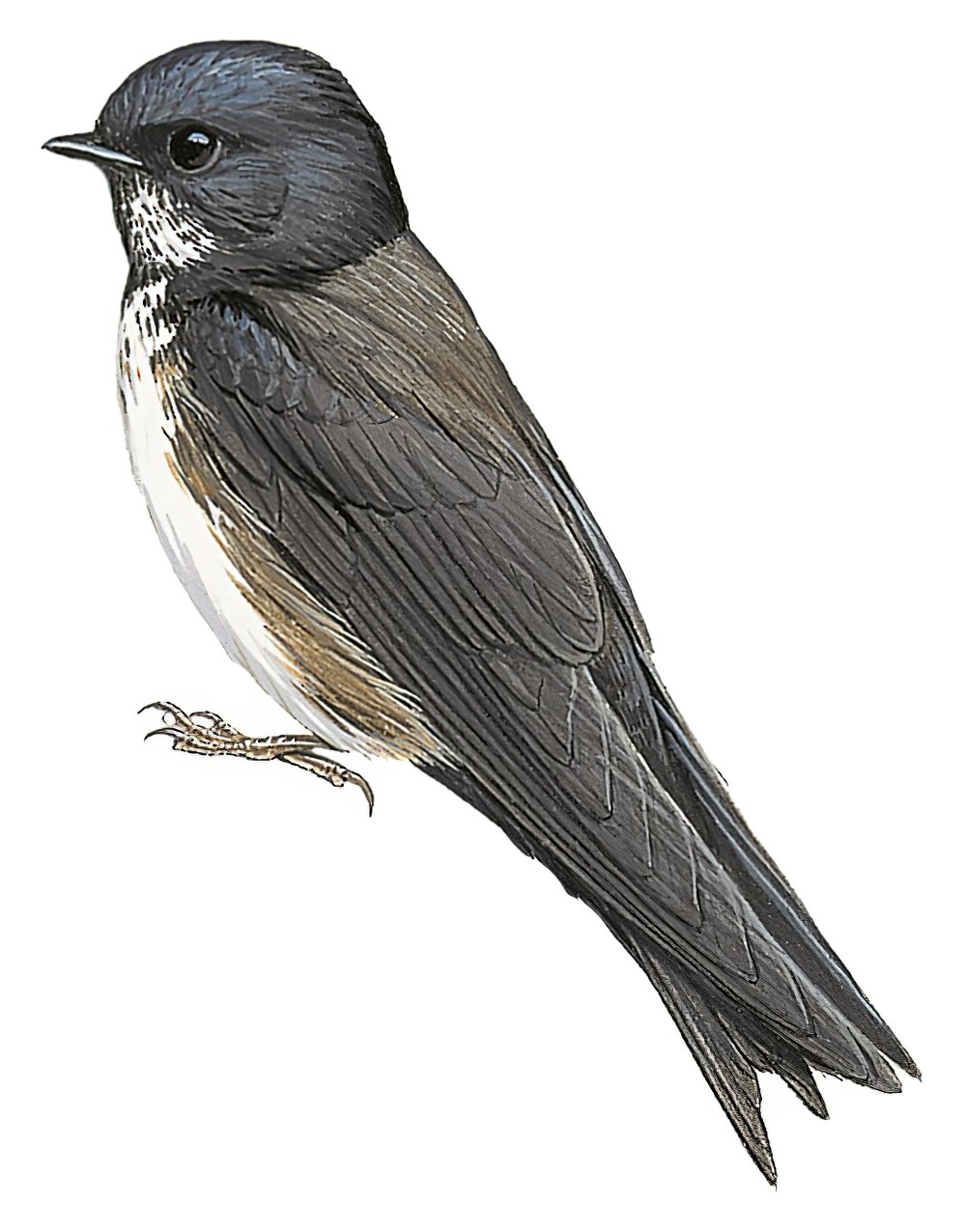Black-capped Swallow / Atticora pileata

Black-capped Swallow
SCI Name:
Protonym: Atticora pileata Proc.Zool.Soc.London Pt26 no.369 p.355
Taxonomy: Passeriformes / Hirundinidae / Atticora
Taxonomy Code: blcswa1
Type Locality: Guatemala.
Author: Gould
Publish Year: 1858
IUCN Status: Least Concern
DEFINITIONS
ATTICORA
(Hirundinidae; Ϯ White-banded Swallow A. fasciata) Gr. Ατθι κορα Atthi kora epithet of the swallow < Αττικος Attikos Attic, Athenian; κορα kora maiden. In ornithology Attic place-names and personal names were commonly coined for swallows and swifts; "ATTICORA LEUCOSTERNON, Gould ... For the present I have placed this new and elegant Swallow with the members of the genus Atticora; the type of which is the Hirundo fasciata of authors, a bird inhabiting South America, from which country I have seen two species, while South Africa presents us with a third; the present, therefore, may be considered as a representative of the genus in Australia" (Gould 1842); "8. Atticora B. 1) Corpus aterrimum, fasciis niveis saepius insignitum. 2) Longitudo 4-7". 3) Cauda forficata. 4) Remigum prima longissima. Iris braun. Schnabel von mittelmäßiger Stärke. Schwungfedern straff. Füße schwach. Schwanz eine vollkommene Gabel bildend. Heller gefärbte Art: H. ambrosiaca." (Boie 1844); "Atticora Boie, 1844, Isis von Oken, col. 172. Type, by subsequent designation, Hirundo fasciata Gmelin (Gray, 1855, Cat. Gen. Subgen. Birds, p. 13)." (Peters 1960, IX, 90); "ATTICORA Gould, 1842 F — Hirundo fasciata auctorum; type by original designation = Hirundo fasciata J. F. Gmelin, 1789 4 ... 4 For correction of author and date see Gregory & Dickinson (2012)" (Dickinson and Christidis (eds.), H. & M. Complete Checklist, 4th ed., 2014, 2 (Passerines), p. 484).
Var. Acticora, Alticora.
Synon. Microchelidon, Neochelidon, Notiochelidon.
pileata / pileatum / pileatus
L. pileatus capped < pileus felt-cap.
● ex “Petit Fouquet des Philippines” of Sonnerat 1782 (syn. Anous stolidus).
● ex “Pigeon verd à tête grise d’Antigue” of Sonnerat 1776 (syn. Chalcophaps indica).
● ex “Souï” or “Petit Tinamou de Cayenne” of d’Aubenton 1765-1781, pl. 829 (syn. Crypturellus soui).
● ex “Gobe-mouche olive de Cayenne” of d’Aubenton 1765-1781, pl. 574, fig. 2 (unident;?Empidonax sp., ?Myiobius sp.).
● ex “Martin- pêcheur de la Chine” of d’Aubenton 1765-1781, pl. 673, “Martin-pêcheur à coïffe noir” of de Buffon 1770-1785, and “Black-capped Kingsfisher” of Latham 1782 (Halcyon).
● "54. PICUS. ... pileatus. 3. P. niger, capite cristato rubro, temporibus alisque albis maculis. Picus niger maximus, capite rubro. Catesb. car. 2. p. 17. t. 17. Kalm. itin. 2. p. 271. Ipecu. Marcgr. bras. 207. Habitat in America. Differt a P. cornicino, quod tempora alba; maculæ aliquot parvæ in alis albæ; caput magis late coccineum." (Linnaeus 1758) (Hylatomus).
● ex “Tangara à coëffe noire de Cayenne” of d’Aubenton 1765-1781, pl. 720, fig. 2 (Nemosia).
● ex “Tangara à coëffe noire de Cayenne” of d’Aubenton 1765-1781, pl. 720, fig. 2, “Coiffe noire” of de B uffon 1770-1783, and “Hooded Tanager” of Latham 1783 (syn. Nemosia pileata).
● ex “Black-hooded Wheat-ear” of Latham 1783 (Oenanthe).
● ex “Héron blanc huppé de Cayenne” of d’Aubenton 1765-1781, pl. 907, and “Héron blanc” of de Buffon 1770-1786 (Pilherodius).
● ex “Perruche à tête noire de Cayenne” of d’Aubenton 1765-1781, pl. 744, “Caïca” of de Buffon 1770-1783, and “Hooded Parrot” of Latham 1781 (syn. Pionopsitta caica).
● ex “Black-capped Shrike” of Latham 1787 (syn. Sakesphorus canadensis).
● ex “Pluvier du Sénégal” of d’Aubenton 1765-1781, “Pluvier coiffé” of de Buffon 1770-1786, and “Hooded Plover” of Latham 1785 (syn. Sarciophorus tectus).
● ex “Perruche de l’isle de Luçon” of Sonnerat 1776 (syn. Tanygnathus lucionensis).
● ex “Bruant du cap de Bonne-Espérance” of d’Aubenton 1765-1781, pl. 386, fig. 2, and “Bonjour-Commandeur” of de Buffon 1770-1785 (syn. Zonotrichia capensis).
Pileata
(syn. Biziura Ϯ Musk Duck B. lobata) L. pileatus capped < pileus felt-cap; "GENUS BIZIURA. — Leach. WATTLE-DUCKS. Hydrobates— Temminck. Pileata— Brown. ... The B. lobata, or Wattle-Duck, is the only species of this genus known. It is a native of Australia, locating on rivers and pools, and is never known to visit the sea. They universally associate in pairs. They dive with much rapidity, and are very difficult to shoot. Nothing is known of their habits." (T. Brown 1845).
UPPERCASE: current genus
Uppercase first letter: generic synonym
● and ● See: generic homonyms
lowercase: species and subspecies
●: early names, variants, mispellings
‡: extinct
†: type species
Gr.: ancient Greek
L.: Latin
<: derived from
syn: synonym of
/: separates historical and modern geographic names
ex: based on
TL: type locality
OD: original diagnosis (genus) or original description (species)












